Popular categories
Looking for a yarn?

100% Wool
from 4.55 $ /50g
The yarn cost is calculated from the pattern’s smallest size and the yarn’s cheapest product type. Looking for an even better price? You might find it on the DROPS Deals!
Now and Forever
Knitted sweater in DROPS Merino Extra Fine. Piece is knitted top down with rolling edge in the neck, round yoke, lace pattern on yoke and short sleeves. Size: S - XXXL
DROPS design: Pattern me-220
Yarn group B
-------------------------------------------------------
SIZE:
S - M - L - XL - XXL – XXXL
Finished measurements:
Chest measurements: 88-96-104-112-126-138 cm = 34⅝"-37¾"-41"-44"-49½"-54¼"
Full length: 46-48-50-52-54-56 cm = 18"-19"-19¾"-20½"-21¼"-22"
All measurements in charts are in cm.
MATERIALS:
DROPS MERINO EXTRA FINE from Garnstudio (belongs to yarn group B)
400-450-500-550-600-650 g color 25, pink
KNITTING GAUGE:
21 stitches in width and 28 rows vertically in stockinette stitch = 10 x 10 cm = 4" x 4".
NEEDLES:
DROPS DOUBLE POINTED NEEDLES SIZE 4 MM = US 6
DROPS CIRCULAR NEEDLE SIZE 4 MM = US 6 : Length 40 = 16" and 60 = 24" or 80 cm = 32" for stockinette stitch.
DROPS DOUBLE POINTED NEEDLES SIZE 3 MM = US 2.5
DROPS CIRCULAR NEEDLE SIZE 3 MM = US 2.5 : Length 40 cm = 16" and 80 cm = 32" for edges.
Needle size is only a suggestion! If you have too many stitches on 10 cm = 4" switch to a larger needle size. If you have too few stitches on 10 cm = 4" switch to a smaller needle size.
-------------------------------------------------------
Alternative Yarn – See how to change yarns here
Yarn Groups A to F – Use the same pattern and change the yarn here
Yarn usage using an alternative yarn – Use our yarn converter here
-------------------------------------------------------

100% Wool
from 4.55 $ /50g
The yarn cost is calculated from the pattern’s smallest size and the yarn’s cheapest product type. Looking for an even better price? You might find it on the DROPS Deals!
- English (US/in)
- Česky
- Dansk
- Deutsch
- Eesti keel
- English (UK/cm)
- Español
- Français
- Íslenska
- Italiano
- Magyar
- Nederlands
- Norsk
- Polski
- Português
- Suomi
- Svenska
- English (UK/cm), Bulgaria
- English (UK/cm), Croatia
- English (UK/cm), Greece
- English (UK/cm), Latvia
- English (UK/cm), Lithuania
- English (UK/cm), Romania
- English (UK/cm), Slovenia
- Česky, Slovakia
Pattern instructions
EXPLANATION FOR THE PATTERN:
-------------------------------------------------------
PATTERN:
See diagrams A.1 to A.3. Choose diagram for your size (applies to A.3).
INCREASE/DECREASE TIP (evenly spaced):
To calculate how to increase/decrease evenly, use the total number of stitches on row (e.g. 100 stitches) and divide stitches by number of increases/decreases to be done (e.g. 44) = 2.3.
In this example increase by making 1 yarn over after approx. every other stitch. On next round knit yarns over twisted to avoid holes.
To decrease knit approx. every 1st and 2nd stitch together.
INCREASE TIP (applies to sides of body):
Work until 4 stitches remain before marker thread, make 1 yarn over, work 8 stitches in stockinette stitch (marker thread is in the middle of these 8 stitches), make 1 yarn over (= 2 stitches increased at the marker thread, and 4 stitches increased in total on round). On next round knit yarns over twisted to avoid holes. Then work the new stitches in stockinette stitch.
BIND-OFF TIP:
To avoid a tight bind-off edge you may use a larger needle size. If this also is too tight, work a 1 yarn over after approx. every 6th stitch while binding off (bind off yarn overs as regular stitches).
-------------------------------------------------------
START THE PIECE HERE:
-------------------------------------------------------
SWEATER - SHORT OVERVIEW OF THE PIECE:
Work neck edge and yoke in the round on circular needle from mid back, top down. Now divide yoke for body and sleeves. Body is worked in the round on circular needle, top down. Work sleeves in the round on double pointed needles/short circular needle, top down.
NECK EDGE:
Cast on 100-104-110-114-118-124 stitches on a short circular needle size 3 MM = US 2.5 with Merino Extra Fine. Work 8 rounds in stockinette stitch (rolling edge). Then work 2 rounds in stockinette stitch and increase at the same time 44-48-50-54-58-60 stitches evenly on first round - read INCREASE/DECREASE TIP = 144-152-160-168-176-184 stitches (knit yarn overs twisted on last round). Insert 1 marker in the middle of round (= mid front). Then work yoke as explained below. Measure yoke from this marker!
YOKE:
Switch to circular needle size 4 MM = US 6 and work A.1 in the round (= 18-19-20-21-22-23 repetitions of 8 stitches). Continue pattern like this, and increase as shown in diagram. REMEMBER THE KNITTING GAUGE!
When A.1 has been worked vertically, there are 288-304-320-336-352-368 stitches on needle.
Then work A.2 in the round (= 18-19-20-21-22-23 repetitions of 16 stitches).
When A.2 has been worked 1-1-1-2-2-2 times vertically, work A.3 in the round (= 18-19-20-21-22-23 repetitions of 16 stitches).
On round marked with arrow in A.3 increase 8-16-28-2-12-26 stitches evenly (there are 288-304-320-378-396-414 stitches on needle before increase begins) - remember INCREASE/DECREASE TIP = 296-320-348-380-408-440.
When entire A.3 has been worked vertically, work in stockinette stitch until piece measures 19-20-22-25-26-28 cm = 7½"-8"-8¾"-9¾"-10¼"-11" from marker by the neck.
Now divide yoke for body and sleeves, i.e. work last round as follows: Work 43-47-51-55-61-67 stitches in stockinette stitch (= ½ back piece), slip the next 62-66-72-80-82-86 stitches on 1 stitch holder for sleeve, cast on 6-6-8-8-10-10 new stitches on needle (= in the side under sleeve), work 86-94-102-110-122-134 stitches in stockinette stitch (= front piece), slip the next 62-66-72-80-82-86 stitches on 1 stitch holder for sleeve, cast on 6-6-8-8-10-10 new stitches on needle (= in the side under sleeve) , and work the remaining 43-47-51-55-61-67 stitches in stockinette stitch as before (= ½ back piece). Finish body and sleeves separately. NOW MEASURE PIECE FROM HERE!
BODY:
= 184-200-220-236-264-288 stitches. Insert 1 marker thread in each side on body– in the middle of the 6-6-8-8-10-10 stitches cast on under each sleeve = 92-100-110-118-132-144 stitches between every marker thread.
Move the marker threads upwards when working; they should be used for increase later in the sides on body.
Work in stockinette stitch in the round. When piece measures 6 cm = 2⅜" from division, increase 1 stitch on each side of both marker threads - read INCREASE TIP( = 4 stitches increased). Increase like this every 6 cm = 2⅜" 3 times in total in each side = 196-212-232-248-276-300 stitches.
Work until piece measures 20-21-21-20-21-21 cm = 8"-8¼"-8¼"-8"-8¼"-8¼" from division. Approx. 3 cm = 1⅛" remain until finished measurements, try the sweater on and work until desired length.
Now increase stitches as explained below - this is done to avoid the rib from contracting the piece together.
Knit 1 round while increasing 29-31-35-37-39-45 stitches evenly = 225-243-267-285-315-345 stitches.
Switch to circular needle size 3 MM = US 2.5. Work 5 rounds rib (= knit 1/purl 2). Then knit 1 round and purl round. Bind off by knitting– read BIND-OFF TIP. Sweater measures approx. 46-48-50-52-54-56 cm = 18"-19"-19¾"-20½"-21¼"-22" from shoulder and down.
SLEEVES:
Slip the 62-66-72-80-82-86 stitches from stitch holder in one side of piece on double pointed needles or a short circular needle size 4 MM = US 6 and pick in addition up 1 stitch in each of the 6-6-8-8-10-10 new stitches cast on under sleeve = 68-72-80-88-92-96 stitches.
Work in stockinette stitch in the round until piece measures 11-10-9-6-6-4 cm = 4⅜"-4"-3½"-2⅜"-2⅜"-1½" from division. Approx. 5 cm = 2" remain until finished measurements, try the sweater on and work until desired length.
Knit 1 round while decreasing 8-6-8-10-8-6 stitches evenly - read INCREASE/DECREASE TIP = 60-66-72-78-84-90 stitches.
Switch to double pointed needles size 3 MM = US 2.5. Work rib in the round = knit 1/purl 2 for 5 cm = 2".
Then knit 1 round and purl 1 round. Bind off by knitting– read BIND-OFF TIP. Sleeve measures approx. 16-15-14-11-11-9 cm = 6¼"-6"-5½"-4⅜"-4⅜"-3½" from division. Work the other sleeve the same way.
Diagram
All measurements in charts are in cm.

|
= knit |

|
= purl |

|
= between 2 stitches make 1 yarn over, on next round knit or purl yarn over as shown in diagram (it should make a hole) |

|
= between 2 stitches make 1 yarn over, on next round knit or purl yarn over twisted as shown in diagram (it should not make a hole) |

|
= knit 2 together (= 1 stitch decreased) |

|
= slip 1 stitch knitwise, knit 1, pass slipped stitch over stitch worked (= 1 stitch decreased) |

|
= in stitch below next stitch knit 1, 1 yarn over, knit 1 (= 2 stitches increased) |

|
= knit 3 stitches |

|
= slip 2 stitches knitwise, knit 1, pass the 2 slipped stitches over stitch worked (= 2 stitches decreased) |

|
= slip 1 stitch knitwise, knit 2 stitches together, pass slipped stitch over stitches worked together (= 2 stitches decreased) |

|
= increase round |
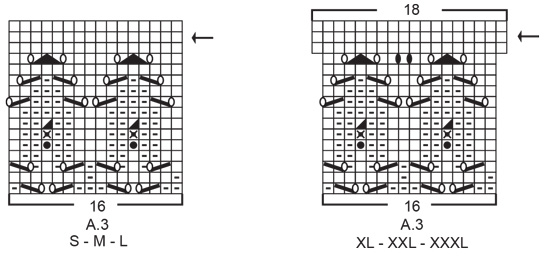
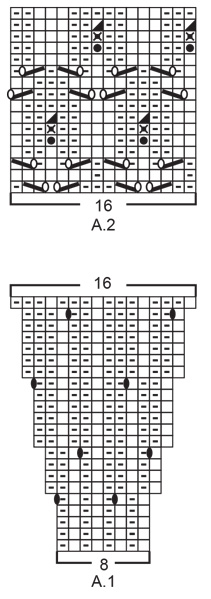
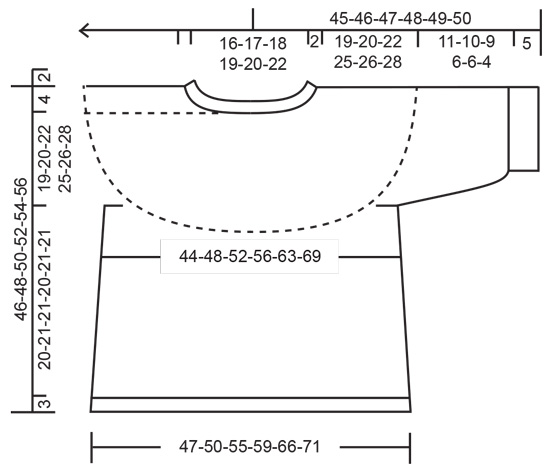
What can you do with our patterns? You can share DROPS patterns online, using the pattern original picture, materials, name and number. But you are NOT ALLOWED to reproduce the complete pattern digitally in any way. Yarn stores are welcome to use the DROPS pattern database to promote the sale of our assortment. You can print out our patterns, make as many copies as you’d like. The only thing we ask is that you don't make any changes / additions to the original printed document. And that the patterns according to the DROPS philosophy are given out to the consumers for free. Editorials that wish to publish our patterns in printed books or magazines can contact us for more information. The sale of garments based on DROPS patterns is permitted as long as they are sold as single items or per order. Further commercial use of the patterns is not permitted. It has to be clearly stated that the garment is made based on a design from DROPS DESIGN. The use of clothing labels of which DROPS DESIGN forms part is conditioned by the inclusion of the following text: “A DROPS DESIGN made by …..”. The use of DROPS photos for marketing purposes/sales is only permitted in connection with the use/sale of DROPS products. The photos may not be cut or edited and the logo should be clearly visible.
We reserve the right to withdraw the permission for use of our patterns at any time, notwithstanding the reason.
Each of our patterns has specific tutorial videos to help you.
These step-by-step tutorials might also help you:
Why is the knitting/crochet tension so important?
Knitting tension is what determines the final measurements of your work, and is usually measured per 10 x 10 cm. It is provided like so: number of stitches in width x number of rows in height - eg: 19 stitches x 26 rows = 10 x 10 cm.
The knitting tension is very individual; some people knit/crochet loosely while others work tightly. You adjust the knitting tension with the needle size, which is why the suggested needle size only serve as a guide! You need to adjust this (up or down) to ensure that YOUR knitting tension matches the knitting tension provided in the pattern. If you work with a different knitting tension than provided you will have a different yarn consumption, and your work will have different measurements than what the pattern suggests.
The knitting tension also determines which yarns can replace each other. As long as you achieve the same knitting tension you can replace one yarn with another.
See DROPS lesson: How to measure your tension/gauge
See DROPS video: How to make a gauge tension swatch
How do I know how many balls of yarn I need?
The required amount of yarn is provided in grams, eg: 450 g. To calculate how many balls you’ll need you first need to know how many grams are in 1 ball (25g, 50g or 100g). This information is available if you click on the individual yarn quality on our pages. Divide the amount required with the amount of each ball. For example, if each ball is 50g (the most common amount), the calculation will be as follows: 450 / 50 = 9 balls.
Can I use a different yarn than what the pattern suggests?
The important thing when changing from one yarn to another is that the knitting/crochet tension remains the same. This is so that the measurements of the finished piece will be the same as on the sketch provided. It is easier to achieve the same knitting tension using yarns from the same yarn group. It is also possible to work with multiple strands of a thinner yarn to achieve the knitting tension of a thicker one. Please try our yarn converter. We recommend you to always work a test swatch.
Please NOTE: when changing yarn the garment might have a different look and feel to the garment in the photo, due to individual properties and qualities of each yarn.
See DROPS lesson: Can I use a different yarn than the one mentioned in the pattern?
What are the yarn groups?
All our yarns are categorised into yarn groups (from A to F) according to thickness and knitting tension – group A contains the thinnest yarns and group F the thickest. This makes it easier for you to find alternative yarns to our patterns, should you wish to switch yarn. All yarns within the same group have a similar knitting tension and can easily replace each other. However, different yarn qualities have different structures and properties which will give the finished work a unique look and feel.
How do I use the yarn converter?
At the top of all our patterns you’ll find a link to our yarn converter, which is a helpful tool should you wish to use a different yarn than suggested. By filling in the yarn quality you wish to replace, the amount (in your size) and number of strands, the converter will present good alternative yarns with the same knitting tension. Additionally it will tell you how much you’ll require in the new qualities and whether you’ll need to work with multiple strands. Most skeins are 50g (some are 25g or 100g).
If the pattern is worked with multiple colours, every colour will have to be converted separately. Similarly, if the pattern is worked with several strands of different yarns (for example 1 strand Alpaca and 1 strand Kid-Silk) you will have to find alternatives for each, individually.
Why do you show discontinued yarns in the patterns?
Since different yarns have different qualities and textures we have chosen to keep the original yarn in our patterns. However, you can easily find options among our available qualities by using our yarn converter, or simply pick a yarn from the same yarn group.
It is possible that some retailers still have discontinued yarns in stock, or that someone has a few skeins at home that they would like to find patterns for.
The yarn converter will provide both alternative yarn as well as required amount in the new quality.
What size should I knit?
If you think it's hard to decide what size to make, it can be a good idea to measure a garment you own already and like the size of. Then you can pick the size by comparing those measures with the ones available in the pattern's size chart.
You'll find the size chart at the bottom of the pattern.
See DROPS lesson: How to read size chart
Why do I get the wrong knitting tension with the suggested needle size?
The needle size provided in the pattern serves only as a guide, the important thing is to follow the knitting tension. And since knitting tension is very individual, you will have to adjust the needle size to ensure that YOUR tension is the same as in the pattern – maybe you’ll have to adjust 1, or even 2 needle sizes, up or down to achieve the correct tension. For this, we recommend that you work test swatches.
Should you work with a different knitting tension than the one provided, the measurements of the finished garment might deviate from the measurement sketch.
See DROPS lesson: How to measure your tension/gauge
See DROPS video: How to make a gauge tension swatch
Why is the pattern worked top-down?
Working a garment top-down provides more flexibility and room for personal adjustment. For example it is easier to try the garment on while working, as well as making adjustments to length of yoke and shoulder caps.
The instructions are carefully explaining every step, in the correct order. Diagrams are adjusted to the knitting direction and are worked as usual.
How do I work according to a knitting diagram?
The diagram depicts all rows/rounds, and every stitch seen from the right side. It is read from bottom to top, from right to left. 1 square = 1 stitch.
When working back and forth, every other row is worked from the right side and every other row is worked from the wrong side. When working from the wrong side, the diagram will have to be worked reversed: from left to right, knit stitches are purled, purl stitches are knit etc.
When working in the round every round is worked from the right side and the diagram are worked from right to left on all rounds.
See DROPS lesson: How to read knitting diagrams
How do I work according to a crochet diagram?
The diagram depicts all rows/rounds, and every stitch seen from the right side. It is worked from bottom to top, from right to left.
When working back and forth every other row is worked from the right side: from right to left and every other row is worked from the wrong side: from left to right.
When working in the round, every row in the diagram are worked from the right side, from right to left.
When working a circular diagram you start in the middle and work your way outwards, counter clockwise, row by row.
The rows usually start with a given number of chain stitches (equivalent to the height of the following stitch), this will either be depicted in the diagram or explained in the pattern.
See DROPS lesson: How to read crochet diagrams
How do I work several diagrams simultaneously on the same row/round?
Instructions for working several diagrams after each other on the same row/round, will often be written like so: “work A.1, A.2, A.3 a total of 0-0-2-3-4 times". This means you work A.1 once, then A.2 is worked once, and A.3 is repeated (in width) the number of times provided for your size – in this case like so: S = 0 times, M = 0 times, L=2 times, XL= 3 times and XXL = 4 times.
The diagrams are worked as usual: begin with the first row in A.1, then work the first row in A.2 etc.
See DROPS lesson: How to read knitting diagrams
See DROPS lesson: How to read crochet diagrams
Why are the sleeves shorter in larger sizes?
The total width of the garment (from wrist-to-wrist) will be larger in the larger sizes, despite the actual sleeves being shorter. The larger sizes have longer sleeve caps and wider shoulders, so there will be a good fit in all sizes.
Where on the garment is the length measured?
The measurement sketch/schematic drawing provides information regarding the full length of the garment. If it’s a jumper or a jacket the length is measured from the highest point on the shoulder (usually closest to the neckline), and straight down to the bottom of the garment. It is NOT measured from the tip of shoulder. Similarly, the length of yoke is measured from the highest point on the shoulder and down to where yoke is split into body and sleeves.
See DROPS lesson: How to read a schematic drawing
What is a repeat?
Diagrams are often repeated on the round or in height. 1 repeat is the diagram the way it appears in the pattern. If it says to work 5 repeats of A.1 in the round, then you work A.1 a total of 5 times after/next to each other in the round. If it says to work 2 repeats of A.1 vertically/in height you work the entire diagram once, then begin again at the start and work the entire diagram one more time.
Why does the piece start with more chain stitches than it’s worked with?
Chain stitches are slightly narrower than other stitches and to avoid working the cast-on edge too tight, we simply chain more stitches to begin with. The stitch count will be adjusted on the following row to fit the pattern and measurement sketch.
Why increase before the rib edge when the piece is worked top-down?
The rib edge is more elastic and will contract slightly compared to, for example, stocking stitch. By increasing before the rib edge, you avoid a visible difference in width between the rib edge and the rest of the body.
Why increase in the cast-off edge?
It’s very easy to cast off too tightly, and by making yarn overs while casting off (and simultaneously casting these off) you avoid a too tight cast off edge.
See DROPS video: How to bind off with yarn overs (yo)
How do I increase/decrease on every 3rd and 4th row/round alternately?
To achieve an even increase (or decrease) you can increase on, for example: every 3rd and 4th row alternately, like so: work 2 rows and increase on the 3rd row, work 3 rows and increase on the 4th. Repeat this until the increase is complete.
See DROPS lesson: Increase or decrease 1 st on every 3rd and 4th row alternately
How can I work a jacket in the round instead of back and forth?
Should you prefer to work in the round instead of back and forth, you may of course adjust the pattern. You’ll need to add steeks mid-front (usually 5 stitches), and follow the instructions. When you would normally turn and work from the wrong side, simply work across the steek and continue in the round. At the end you’ll cut the piece open, pick up stitches to work bands, and cover the cut edges.
See DROPS video: How to knit steeks and cut open
Can I work a jumper back and forth instead of in the round?
Should you prefer to work back and forth instead of in the round, you may of course adjust the pattern so you work the pieces separately and then assemble them at the end. Divide the stitches for the body in 2, add 1 edge stitch in each side (for sewing) and work the front and back pieces separately.
See DROPS lesson: Can I adapt a pattern for circular needles into straight needles?
Why is the pattern slightly different than what I see in the photo?
Pattern repeats can vary slightly in the different sizes, in order to get the correct proportions. If you’re not working the exact same size as the garment in the photo, yours might deviate slightly. This has been carefully developed and adjusted so that the complete impression of the garment is the same in all sizes.
Make sure to follow instructions and diagrams for your size!
How do I make a women’s size garment into a men’s size one?
If you have found a pattern you like which is available in women’s size it’s not very difficult to convert it to men’s size. The biggest difference will be the length of sleeves and body. Start working on the women size that you think would fit across the chest. The additional length will be worked right before you cast off for the armhole/sleeve cap. If the pattern is worked top-down you can add the length right after the armhole or before the first decrease on sleeve.
Regarding additional yarn amount, this will depend on how much length you add, but it is better with a skein too many than too few.
How do I prevent a hairy garment from shedding?
All yarns will have excess fibres (from production) that might come off as lint or shedding. Brushed yarns (ie hairier yarns) have more of these loose, excess fibres, causing more shedding.
Shedding also depends on what is worn under or over the garment, and whether this pulls at the yarn fibres. It’s therefore not possible to guarantee that there will be no shedding
Below are some tips on how to get the best result when working with hairier yarns:
1. When the garment is finished (before you wash it) shake it vigorously so the looser hairs come off. NOTE: do NOT use a lint roller, brush or any method that pulls at the yarn.
2. Place the garment in a plastic bag and put it in your freezer - the temperature will cause the fibres to become less attached to each other, and excess fibres will come off easier.
3. Leave in the freezer for a few hours before taking it out and shaking it again.
4. Wash the garment according to the instructions on the yarn label.
Why does my garment pill?
Pilling is a natural process that happens to even the most exclusive of fibers. It's a natural sign of wear and tear that is hard to avoid, and that is most visible in high friction areas of your garment like a sweater's arms and cuffs.
You can make your garment look as new by removing the pilling, using a fabric comb or a pill/lint remover.
In the meantime, you can read the questions and answers that others have left to this pattern or join the DROPS Workshop on Facebook to get help from fellow knitters/crocheters!
You might also like...
Now and Forever |
||||||||||||||||||||||||||||||||||
 |
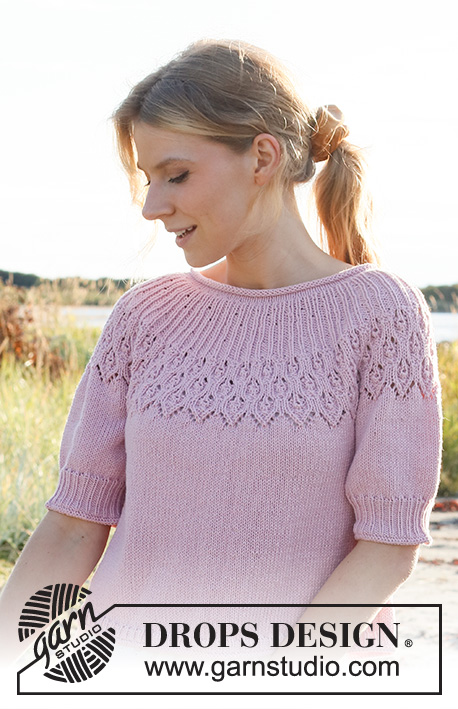 |
|||||||||||||||||||||||||||||||||
Knitted sweater in DROPS Merino Extra Fine. Piece is knitted top down with rolling edge in the neck, round yoke, lace pattern on yoke and short sleeves. Size: S - XXXL
DROPS 222-34 |
||||||||||||||||||||||||||||||||||
|
------------------------------------------------------- EXPLANATION FOR THE PATTERN: ------------------------------------------------------- PATTERN: See diagrams A.1 to A.3. Choose diagram for your size (applies to A.3). INCREASE/DECREASE TIP (evenly spaced): To calculate how to increase/decrease evenly, use the total number of stitches on row (e.g. 100 stitches) and divide stitches by number of increases/decreases to be done (e.g. 44) = 2.3. In this example increase by making 1 yarn over after approx. every other stitch. On next round knit yarns over twisted to avoid holes. To decrease knit approx. every 1st and 2nd stitch together. INCREASE TIP (applies to sides of body): Work until 4 stitches remain before marker thread, make 1 yarn over, work 8 stitches in stockinette stitch (marker thread is in the middle of these 8 stitches), make 1 yarn over (= 2 stitches increased at the marker thread, and 4 stitches increased in total on round). On next round knit yarns over twisted to avoid holes. Then work the new stitches in stockinette stitch. BIND-OFF TIP: To avoid a tight bind-off edge you may use a larger needle size. If this also is too tight, work a 1 yarn over after approx. every 6th stitch while binding off (bind off yarn overs as regular stitches). ------------------------------------------------------- START THE PIECE HERE: ------------------------------------------------------- SWEATER - SHORT OVERVIEW OF THE PIECE: Work neck edge and yoke in the round on circular needle from mid back, top down. Now divide yoke for body and sleeves. Body is worked in the round on circular needle, top down. Work sleeves in the round on double pointed needles/short circular needle, top down. NECK EDGE: Cast on 100-104-110-114-118-124 stitches on a short circular needle size 3 MM = US 2.5 with Merino Extra Fine. Work 8 rounds in stockinette stitch (rolling edge). Then work 2 rounds in stockinette stitch and increase at the same time 44-48-50-54-58-60 stitches evenly on first round - read INCREASE/DECREASE TIP = 144-152-160-168-176-184 stitches (knit yarn overs twisted on last round). Insert 1 marker in the middle of round (= mid front). Then work yoke as explained below. Measure yoke from this marker! YOKE: Switch to circular needle size 4 MM = US 6 and work A.1 in the round (= 18-19-20-21-22-23 repetitions of 8 stitches). Continue pattern like this, and increase as shown in diagram. REMEMBER THE KNITTING GAUGE! When A.1 has been worked vertically, there are 288-304-320-336-352-368 stitches on needle. Then work A.2 in the round (= 18-19-20-21-22-23 repetitions of 16 stitches). When A.2 has been worked 1-1-1-2-2-2 times vertically, work A.3 in the round (= 18-19-20-21-22-23 repetitions of 16 stitches). On round marked with arrow in A.3 increase 8-16-28-2-12-26 stitches evenly (there are 288-304-320-378-396-414 stitches on needle before increase begins) - remember INCREASE/DECREASE TIP = 296-320-348-380-408-440. When entire A.3 has been worked vertically, work in stockinette stitch until piece measures 19-20-22-25-26-28 cm = 7½"-8"-8¾"-9¾"-10¼"-11" from marker by the neck. Now divide yoke for body and sleeves, i.e. work last round as follows: Work 43-47-51-55-61-67 stitches in stockinette stitch (= ½ back piece), slip the next 62-66-72-80-82-86 stitches on 1 stitch holder for sleeve, cast on 6-6-8-8-10-10 new stitches on needle (= in the side under sleeve), work 86-94-102-110-122-134 stitches in stockinette stitch (= front piece), slip the next 62-66-72-80-82-86 stitches on 1 stitch holder for sleeve, cast on 6-6-8-8-10-10 new stitches on needle (= in the side under sleeve) , and work the remaining 43-47-51-55-61-67 stitches in stockinette stitch as before (= ½ back piece). Finish body and sleeves separately. NOW MEASURE PIECE FROM HERE! BODY: = 184-200-220-236-264-288 stitches. Insert 1 marker thread in each side on body– in the middle of the 6-6-8-8-10-10 stitches cast on under each sleeve = 92-100-110-118-132-144 stitches between every marker thread. Move the marker threads upwards when working; they should be used for increase later in the sides on body. Work in stockinette stitch in the round. When piece measures 6 cm = 2⅜" from division, increase 1 stitch on each side of both marker threads - read INCREASE TIP( = 4 stitches increased). Increase like this every 6 cm = 2⅜" 3 times in total in each side = 196-212-232-248-276-300 stitches. Work until piece measures 20-21-21-20-21-21 cm = 8"-8¼"-8¼"-8"-8¼"-8¼" from division. Approx. 3 cm = 1⅛" remain until finished measurements, try the sweater on and work until desired length. Now increase stitches as explained below - this is done to avoid the rib from contracting the piece together. Knit 1 round while increasing 29-31-35-37-39-45 stitches evenly = 225-243-267-285-315-345 stitches. Switch to circular needle size 3 MM = US 2.5. Work 5 rounds rib (= knit 1/purl 2). Then knit 1 round and purl round. Bind off by knitting– read BIND-OFF TIP. Sweater measures approx. 46-48-50-52-54-56 cm = 18"-19"-19¾"-20½"-21¼"-22" from shoulder and down. SLEEVES: Slip the 62-66-72-80-82-86 stitches from stitch holder in one side of piece on double pointed needles or a short circular needle size 4 MM = US 6 and pick in addition up 1 stitch in each of the 6-6-8-8-10-10 new stitches cast on under sleeve = 68-72-80-88-92-96 stitches. Work in stockinette stitch in the round until piece measures 11-10-9-6-6-4 cm = 4⅜"-4"-3½"-2⅜"-2⅜"-1½" from division. Approx. 5 cm = 2" remain until finished measurements, try the sweater on and work until desired length. Knit 1 round while decreasing 8-6-8-10-8-6 stitches evenly - read INCREASE/DECREASE TIP = 60-66-72-78-84-90 stitches. Switch to double pointed needles size 3 MM = US 2.5. Work rib in the round = knit 1/purl 2 for 5 cm = 2". Then knit 1 round and purl 1 round. Bind off by knitting– read BIND-OFF TIP. Sleeve measures approx. 16-15-14-11-11-9 cm = 6¼"-6"-5½"-4⅜"-4⅜"-3½" from division. Work the other sleeve the same way. |
||||||||||||||||||||||||||||||||||
Diagram explanations |
||||||||||||||||||||||||||||||||||
|
||||||||||||||||||||||||||||||||||

|
||||||||||||||||||||||||||||||||||

|
||||||||||||||||||||||||||||||||||

|
||||||||||||||||||||||||||||||||||
|
Have you made this or any other of our designs? Tag your pictures in social media with #dropsdesign so we can see them! Do you need help with this pattern?You'll find tutorial videos, a Comments/Questions area and more by visiting the pattern on garnstudio.com. © 1982-2024 DROPS Design A/S. We reserve all rights. This document, including all its sub-sections, has copyrights. Read more about what you can do with our patterns at the bottom of each pattern on our site. |
||||||||||||||||||||||||||||||||||
With over 40 years in knitting and crochet design, DROPS Design offers one of the most extensive collections of free patterns on the internet - translated to 17 languages. As of today we count 304 catalogs and 11422 patterns - 11417 of which are translated into English (US/in).
We work hard to bring you the best knitting and crochet have to offer, inspiration and advice as well as great quality yarns at incredible prices! Would you like to use our patterns for other than personal use? You can read what you are allowed to do in the Copyright text at the bottom of all our patterns. Happy crafting!







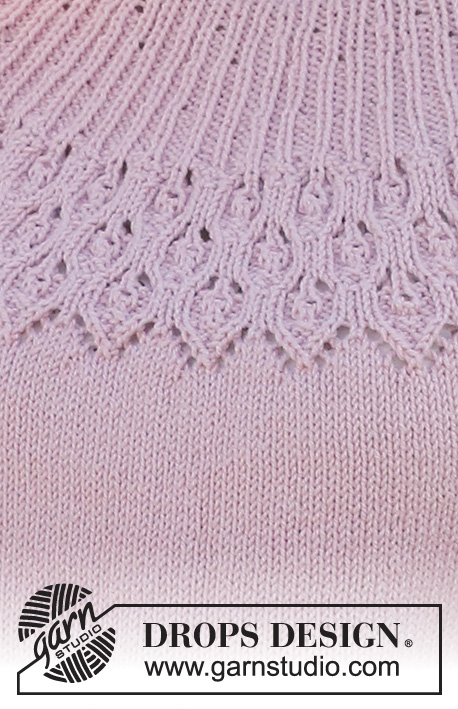

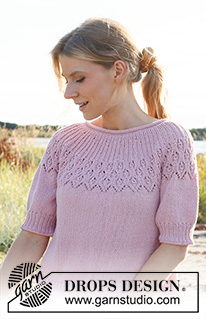
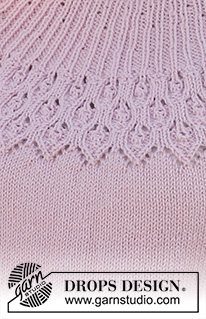






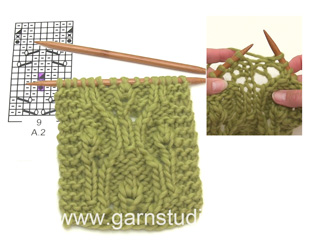



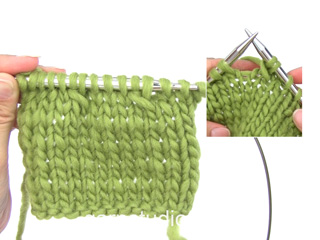









































Comments / Questions (15)
Hello Drops team, My question is : I have knitted lots of sweaters based on your patterns as I do absolutely love them. I would like to try and sell them just to make little money for myself ( so I can afford more yarn). Some of those sweaters are modified by me ( ribbed next instead rolled one, long sleeve instead short, etc) Is it still ok for me to sell modified versions of those sweaters ? Thank you for your help Kind regards Magdalena
08.02.2024 - 12:26DROPS Design answered:
Dear Magdalena, please find all informations required under the copyright at the bottom of each pattern page. Happy knitting!
08.02.2024 - 15:51Hej igen! Tittade på Daisy Lane mönstret ni rekommenderade istället, har funderat på den. Jag tyckte denna var så fin med rullkanten, jag antar att det blir konstigt i mönstret om jag försöker sticka en rullkant i halsringningen på det mönstret? Eller går det? Stickar jag bara slätstickning då och isåfall hur många varv dvs när ska jag ” hoppa in i mönstret” igen? Annars får jag väl testa med denna det kanske märks ganska snabbt om det funkar eller inte./ Hälsn. Ida
31.05.2023 - 09:57DROPS Design answered:
Hej Ida, det er kun de første 8 omgange glatstrik som før rullkanten, ja og da du strikker oppefra og ned, så er det bare at sætte maskerne på et par ekstra pinde, så du kan prøve selve pasformen undervejs :)
01.06.2023 - 14:27Hej! Jag har aldrig stickat en tröja förut men funderar på att prova. Kan jag sticka denna utan mönster dvs hoppa över diagraminstruktionerna och bara sticka slätstickning där istället? Finns det någon film som visar hur man stickar omslag vridet räta? / Tack på förhand!
30.05.2023 - 13:16DROPS Design answered:
Hei Ida. Kan ikke gi noen 100% riktig svar, da vi ikke har strikket denne toppen i glattstrikk og vet resultatet. Mener det skal gå greit, så lenge strikkefastheten overholdes. Men ta en titt på Daisy Lane i DROPS 231-53, det er en topp i glattstrikk og selv om den har splitt nederst kan man jo heller lage kanten som du ser i 222-34. Ta en titt på videoen "Omslag", selv om den viser hvordan man strikker et omslag fra vrangen er prinsippet det samme når det strikkes fra rettsiden - strikk i bakre maskebue . mvh DROPS Design
30.05.2023 - 14:08Proszę mi powiedzieć czy schemat pokazuje wyłącznie prawą stronę robótki czy prawą i lewą?
05.05.2023 - 15:54DROPS Design answered:
Witaj Agnieszko, schemat pokazuje prawą stronę robótki, wszystkie rzędy. W tym przypadku sweterek jest przerabiany na okrągło, to oznacza, że wszystkie okrążenia będą wykonywane wyłącznie na prawej stronie robótki. Zachęcam do zapoznania się z kursem DROPS Jak odczytywać schematy w robótce na drutach, część dotyczącą przerabiania 'na okrągło'. W razie dodatkowych pytań służę pomocą. Pozdrawiam!
05.05.2023 - 16:08A2 kuviossa: X= neulo 3 silmukkaa oikein. Tarkoitetaanko tässä että neulotaan 3 silmukkaa yhteen oikealla silmukalla? Tai neulotaanko yhteen silmukkaan 3 s oikein?
22.11.2022 - 17:44DROPS Design answered:
Tämän ruudun kohdalla neulotaan 3 silmukkaa oikein, eli oikea silmukka neulotaan oikein, langankierto neulotaan oikein ja oikea silmukka neulotaan oikein (edellisellä kerroksella lisättiin 2 silmukkaa).
28.11.2022 - 18:11A2 kuviossa: X= neulo 3 silmukkaa oikein. Tarkoitetaanko tässä että neulotaan 3 silmukkaa yhteen oikealla silmukalla? Tai neulotaanko yhteen silmukkaan 3 s oikein?
17.11.2022 - 20:06All'inizio della spiegazione dello sprone c'e' scritto "Passare ai ferri circolari n° 4 mm e lavorare A.1 in tondo (= 144-152-160-168-176-184 ripetizioni di 8 maglie)" in realta' sarebbe 18 ...ripetizioni di 8 maglie, corretto? Grazie
13.11.2021 - 18:03DROPS Design answered:
Buonasera Simona, grazie per la segnalazione: abbiamo corretto il testo. Buon lavoro!
16.11.2021 - 22:25I figured it out....needed to count the 16 underarm stitches
26.05.2021 - 23:30In your Drops pattern 222-334 size XL ...after I finished pattern 3 and added the two stitches I have 380 stitches but when I do the deciding for body and sleeves, the stitches total 396... am I reading the pattern wrong?
26.05.2021 - 23:20DROPS Design answered:
Hi Marlene, The number of stitches on the yoke, before dividing for the sleeves and body is 380 as you say. You work 55 stitches, place 80 on a thread for the sleeve, cast on 8 (which are not counted here as they are added on to the total), work 110, 80 on thread, cast on 8 (not counted) and work 55. 55 + 80 + 110 + 80 + 55 = 380. Hope this helps and happy knitting!
27.05.2021 - 07:40Ik begrijp de uitleg in patroon A3, ivm het meerderen op de gemarkeerde naald. Ik heb nu 336 steken na het volgen van patroon A2, volg maat XL, en zou 2 steken moeten meerderen. En er zouden 378 steken moeten op mijn naald staan voordat ik het meerderen begin (dus plots 42 steken meer). En 380 na het meerderen.
12.05.2021 - 12:38DROPS Design answered:
Dag Mireille
In de 13e toer van A.3 zijn meerderingen opgenomen in de vorm van omslagen die je op de volgende naald gedraaid breit. Hierdoor zitten er 18 steken in A.3 (in plaats van 16) en komt het totaal aantal steken (voordat je de 2 steken meerdert op (18 x 21 herhalingen =) 378. Met de 2 meerderingen er bij kom je op 380. Dus het gaat goed.
15.05.2021 - 14:28